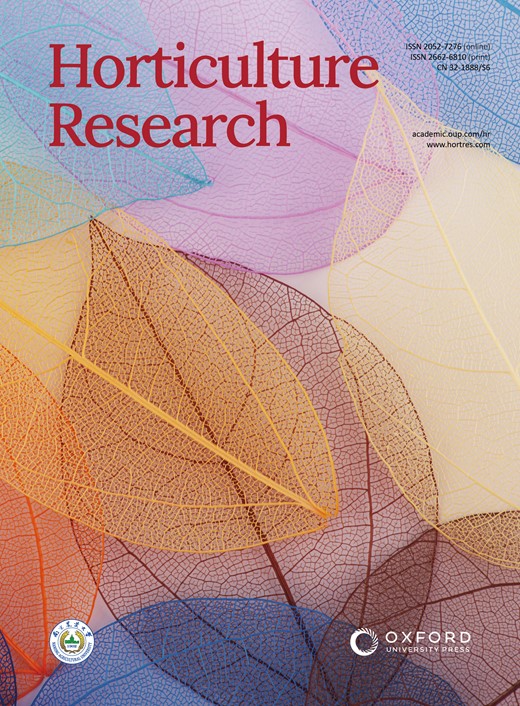栽培橄榄树花期的全基因组关联分析
IF 8.7
1区 农林科学
Q1 Agricultural and Biological Sciences
引用次数: 0
摘要
多年生果树的花期是果实生产的一个重要特征。根据冬季和春季气温的不同,橄榄的花期可能提前、推迟甚至被抑制。因此,破译花期的遗传控制是帮助选择更适应当前气候环境的栽培品种的关键。在此,我们基于摩洛哥马拉喀什全球橄榄种质库中 318 个基因型的捕获测序数据,研究了栽培橄榄全花期的遗传决定因素。根据基因型的推测来源,该种质库的遗传结构分为三个群组,大致归属于地中海东部、中部和西部地区。七年来收集的花期被用来估计基因型最佳线性无偏预测因子,然后在全基因组关联研究中对其进行分析。通过单基因位点或多基因位点方法,具有小效应的基因位点与所研究的性状显著相关。三个最稳健的位点分别位于 01 号和 04 号染色体以及一个支架上,分别解释了 7.1%、6.2% 和 6.5%的性状变异。与基于 LASSO 的基因组预测模型相比,基于 Ridge 的最佳线性无偏预测花期的准确率明显更高。与基因组关联结果一起,这表明花期具有复杂的多基因决定性,正如在许多其他多年生水果植物中看到的那样。这些结果以及对相关区域候选基因的筛选为针对花期的进一步研究和育种计划开辟了前景。本文章由计算机程序翻译,如有差异,请以英文原文为准。
Genome-wide association analysis of flowering date in a collection of cultivated olive tree
Flowering date in perennial fruit trees is an important trait for fruit production. Depending on the winter and spring temperatures, flowering of olive may be advanced, delayed, or even suppressed. Deciphering the genetic control of flowering date is thus key to help selecting cultivars better adapted to the current climate context. Here, we investigated the genetic determinism of full flowering date stage in cultivated olive based on capture sequencing data of 318 genotypes from the worldwide olive germplasm bank of Marrakech, Morocco. The genetic structure of this collection was organized in three clusters that were broadly attributed to eastern, central, and western Mediterranean regions, based on the presumed origin of genotypes. Flowering dates, collected over seven years, were used to estimate the genotypic best linear unbiased predictors, which were then analyzed in a genome-wide association study. Loci with small effects were significantly associated with the studied trait, by either a single- or a multi-locus approach. The three most robust loci were located on chromosomes 01 and 04, and on a scaffold, and explained 7.1%, 6.2%, and 6.5% of the trait variance, respectively. A significantly higher accuracy in the best linear unbiased predictors of flowering date prediction was reported with Ridge- compared to LASSO-based genomic prediction model. Along with genomic association results, this suggests a complex polygenic determinism of flowering date, as seen in many other fruit perennials. These results and the screening of associated regions for candidate genes open perspectives for further studies and breeding programs targeting flowering date.
求助全文
通过发布文献求助,成功后即可免费获取论文全文。
去求助
来源期刊

Horticulture Research
Biochemistry, Genetics and Molecular Biology-Biochemistry
CiteScore
11.20
自引率
6.90%
发文量
367
审稿时长
20 weeks
期刊介绍:
Horticulture Research, an open access journal affiliated with Nanjing Agricultural University, has achieved the prestigious ranking of number one in the Horticulture category of the Journal Citation Reports ™ from Clarivate, 2022. As a leading publication in the field, the journal is dedicated to disseminating original research articles, comprehensive reviews, insightful perspectives, thought-provoking comments, and valuable correspondence articles and letters to the editor. Its scope encompasses all vital aspects of horticultural plants and disciplines, such as biotechnology, breeding, cellular and molecular biology, evolution, genetics, inter-species interactions, physiology, and the origination and domestication of crops.
 求助内容:
求助内容: 应助结果提醒方式:
应助结果提醒方式:


